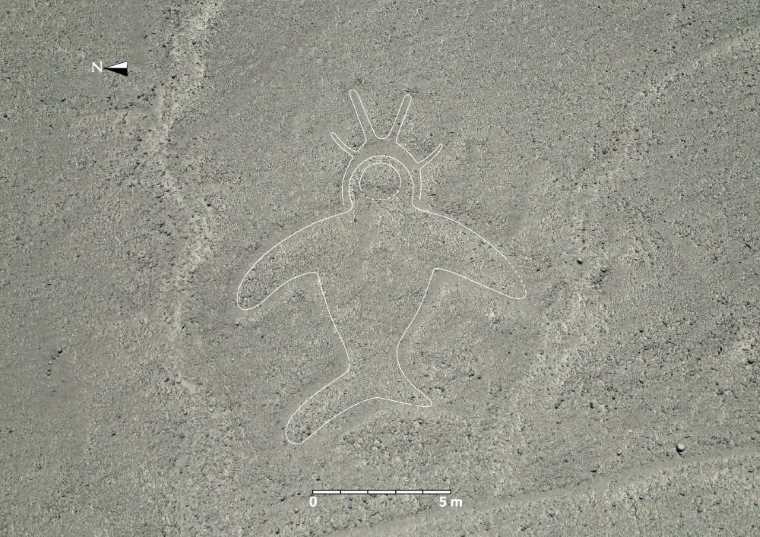
Posted on 09/25/2024 7:01:57 PM PDT by Red Badger

A newly discovered geoglyph on the Nazca Pama. Image credit: Sakai et al.
Advanced artificial intelligence (AI) has helped identify over 300 previously unknown ‘Nazca Lines’ geoglyphs, according to newly published findings. Discovered over a six-month period, the total number of images located using the new process nearly matches the 430 previously known Nazca Lines geoglyphs found more than 80 years ago.
The discoveries, reported by a research team led by Masato Sakai from Yamagata University in Japan, are helping unravel the possible meaning of these ancient artworks, some of which are 2,000 years old, and point to the likely existence of more Nazca Lines geoglyphs awaiting discovery.
The Mysterious History of the Nazca Lines
“In the Nasca Pampa, there are many other geoglyphs that have not yet been investigated,” Mr. Sakai explained in an email to The Debrief. According to Sakai and his team, the Nazca Lines are located 50 kilometers inland from the south coast of Peru, on a desert tableland about 500 meters above sea level.
The team also notes that these geoglyphs have survived for millennia “because they were constructed in an area not easily affected by flooding and not suitable for agriculture.”
In a published study outlining their newly discovered geoglyph treasure trove, the researchers note that the geoglyphs and associated motifs that cover large portions of the ground were made “by manipulating surface stones or gravel.” At least 50 of these massive artworks have been identified, dating back to their discovery by Western scientists in the 1940s.
Since the largest of these designs are most recognizable from the air and no record of these ancient people conquering flight exists, their mere existence has spawned several far-out theories. Among the most common is a proposal that these early people knew how to take flight. Even more controversial proposals involve the natives creating huge line-type drawings of animals and people for the viewing pleasure of ancient alien visitors.
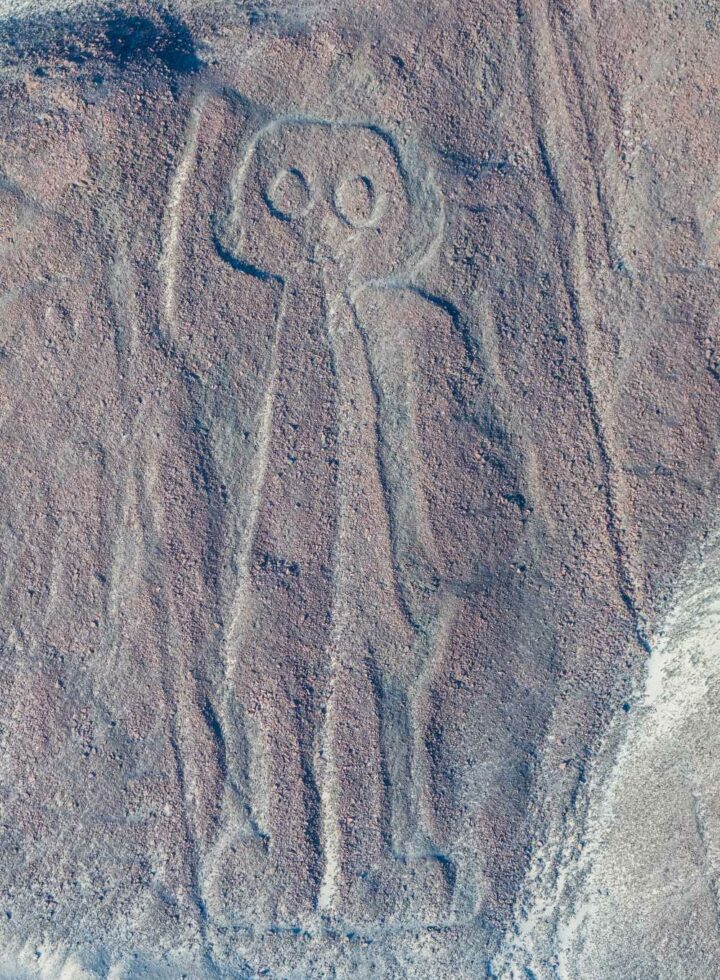
Nazca Lines
One of the larger Nazca Lines has been dubbed “the Astronaut” due to its resemblance to an Apollo-era American astronaut in a spacesuit (Credit: Diego Delso, CC BY-SA 4.0).
While noting there is no evidence to support those ideas proposed by amateur theorists, mainstream archaeologists have proposed more scientifically grounded theories based on decades of research. The authors of this study put them into five different categories, which they say are “not totally unrelated.”
“These are i) calendar and astronomy, ii) geometry, iii) agriculture and irrigation, iv) movement or communication, including walking, running, and dancing, and v) artistic expression,” they write.
To discover previously hidden geoglyphs while simultaneously shedding some light on their actual purpose, Sakai and colleagues employed a technology not available to previous generations of researchers, including both mainstream scientists and alternative theorists: AI. Specifically, Sakai told The Debrief his team used an AI imaging tool called ResNet50. The result is a treasure trove of geoglyphs that they say “provide(s) archaeologists with a unique window into the cultures and beliefs of the ancient people who started to use them at least 2,000 (years) ago.”
different Varieties of geoglyphs on the Nazca Pampa
Approximately 430 previously identified geoglyphs exist, but only 50 are the more well-known large line type that can be seen clearly from the air. The rest can be broken into subcategories, including geometric and figurative glyphs. According to Sakai and colleagues, the several-kilometer-long Nazca lines are part of the linear style of geometric geoglyphs. In contrast, the giant trapezoids are part of the aerial style of geometric geoglyphs. All geoglyphs appear to depict a handful of object categories and motifs.
“Known figurative geoglyphs depict humanoids, animals (bird, monkey, fox, spider, lizard, killer whale, whale, fish, feline, and camelid), plants (flower, seaweed, rhizome, and tree), and tools (needle, loom, pin, fan, and musical instrument),” they write.
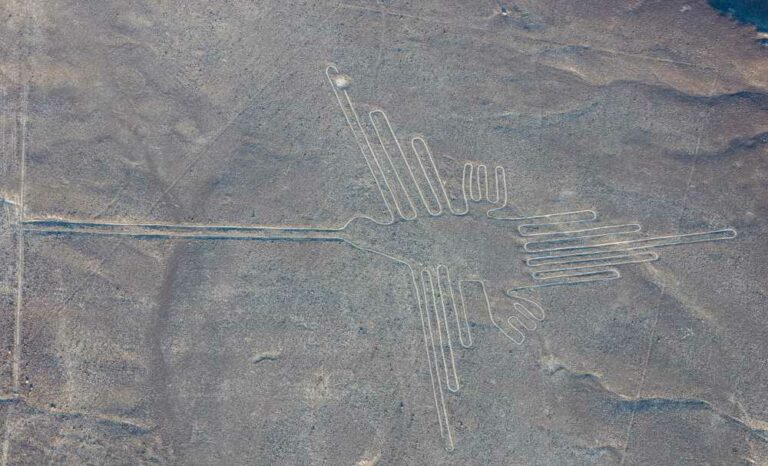
Nazca lines
Picture of a line-type geoglyph titled “The hummingbird” (Credit: Diego Delso, CC BY-SA 4.0)
These figurative glyphs are also found in two distinct styles: the massive line type and the smaller relief type. The line types average 90 meters in length, of which the team confirmed 50 by walking the Pampa grounds, 64% of which depict wild animals. Conversely, the team found that the relief-type figurative geoglyphs averaged only 9 meters in size. These often depict “humanoids” and domesticated animals such as llamas. One of the new images depicts a humanoid figure with an unidentified animal.
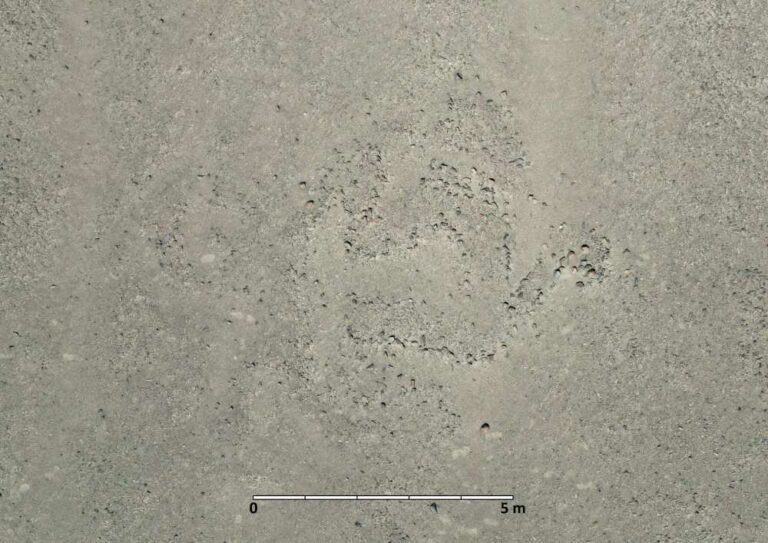
Nazca lines
Raw image of newly discovered relief-type geoglyph described as “Human and Animal” (Credit: Sakai et al.).
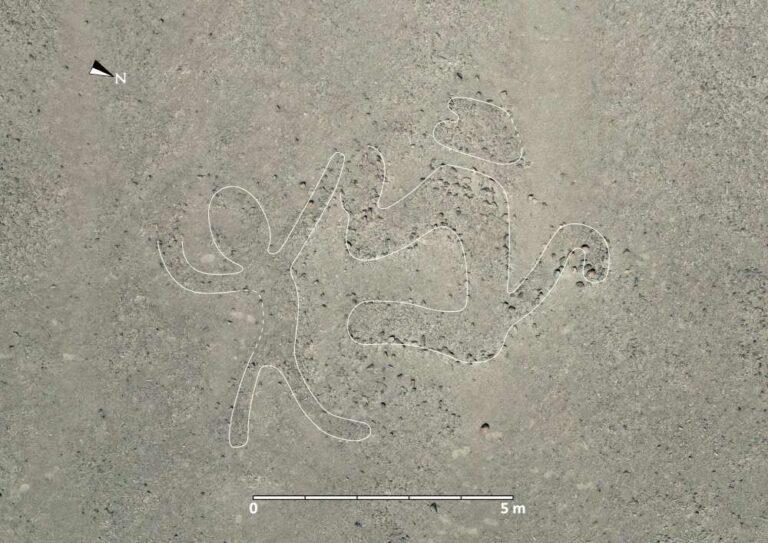
Nazca lines
AI-enhanced image of the “Human and Animal” geoglyph (Credit: Sakai et al.).
Unlike the more famous line-type geoglyphs, which are made by lining up stones to form recognizable shapes, these newly discovered geoglyphs are all smaller relief types that are much more difficult to identify with the naked eye.
When The Debrief asked if the geoglyphs were all constructed around the same time, Sakai said they are likely from different periods of history.
“According to previous research, the relief-type geoglyphs are older,” Sakai told The Debrief.
Newly Discovered Geoglyphs Include a Killer Whale Holding a Knife After six months of scanning the terrain, the AI software identified various styles and themes of Nazca Lines. According to the study, 81.6% of the relief-type geoglyphs depicted humans or domestic animals. While some were more easily recognizable, many likely would have been impossible to detect without the help of AI.
When asked if any newly identified drawings appeared to depict extinct animals, like the recently discovered South African cave paintings that may show a lizard-like creature that died off over 200 million years ago, reported by The Debrief, Sakai said some animals were easier to identify. For example, one relief-style geoglyph appears to be a bird.
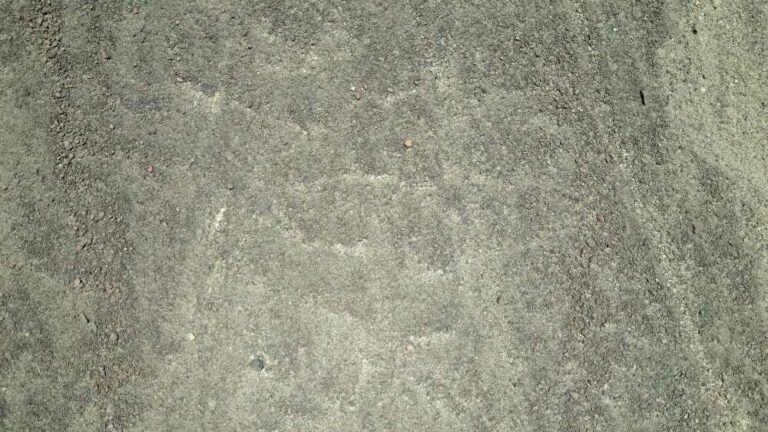
Nazca lines
“Naked Eye” image of one of the newly discovered Nazca Lines the researchers titled “Bird” (Credit: Sakai et al.).
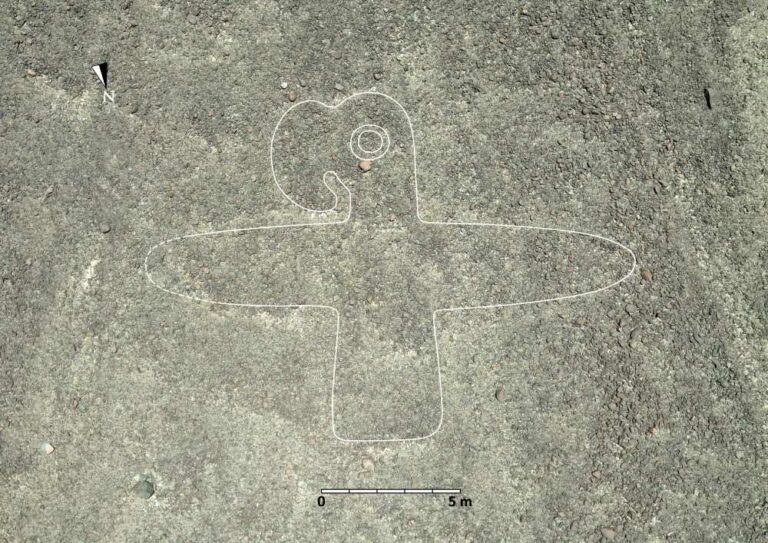
Nazca lines
AI enhanced image of the newly discovered geoglyph, “Bird” (Credit: Sakai et al.). Sakai also said the exact nature of many animals depicted was not immediately evident.
“There are some animals that are difficult to identify,” he told The Debrief. “In such cases, we classified them as ‘animals’.”

Nazca lines
Raw image of an ancient geoglyph titled “animal” (Credit: Sakai et al.).
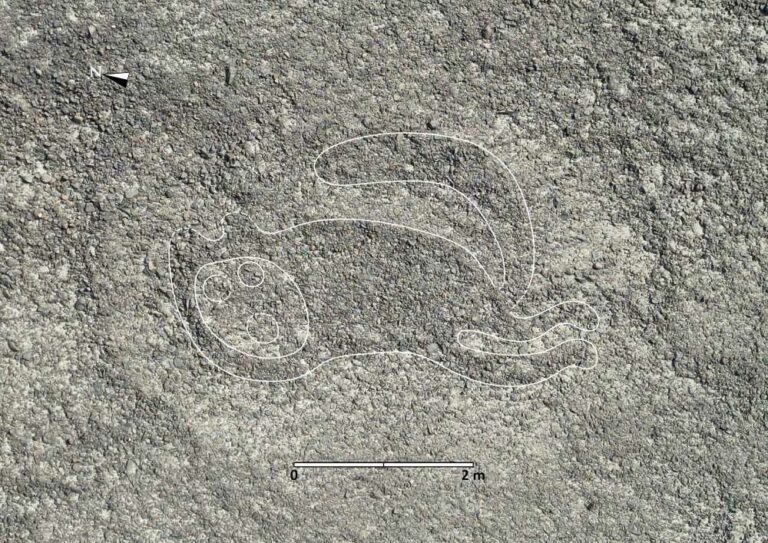
Nazca lines
AI-enhanced image of “animal” geoglyph (Credit: Sakai et al.).
Mr. Sakai provided a list of 14 of the most recognizable geoglyphs, all depicting humans, animals, or a combination of the two. Among the most striking is a pair of glyphs depicting what looks like a shark holding a shovel-shaped object. The researchers categorize these two geoglyphs as “Orca with a Knife.”
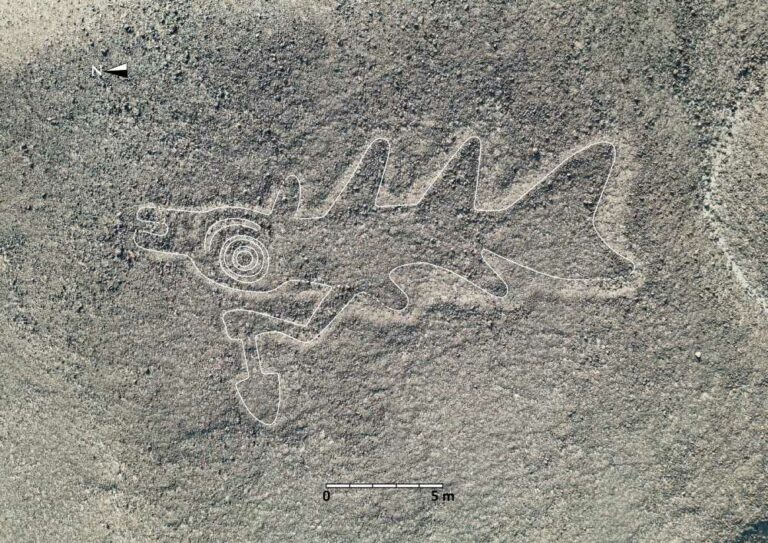
nazca lines
Raw image of geoglyph titled “Orca with a Knife” (Credit: Sakai et al.).
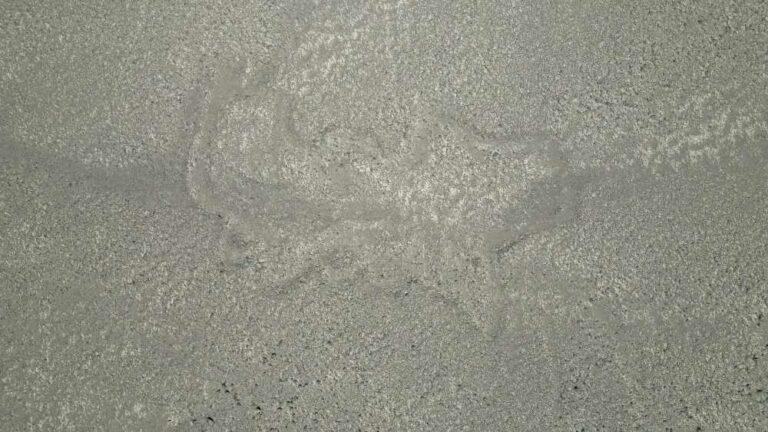
Nazca lines
AI-enhanced image of “Orca with a Knife” (Credit: Sakai et al.).
Nazca lines
Raw image of a second geoglyph also identified as “Orca with a Knife” (Credit: Sakai et al.).
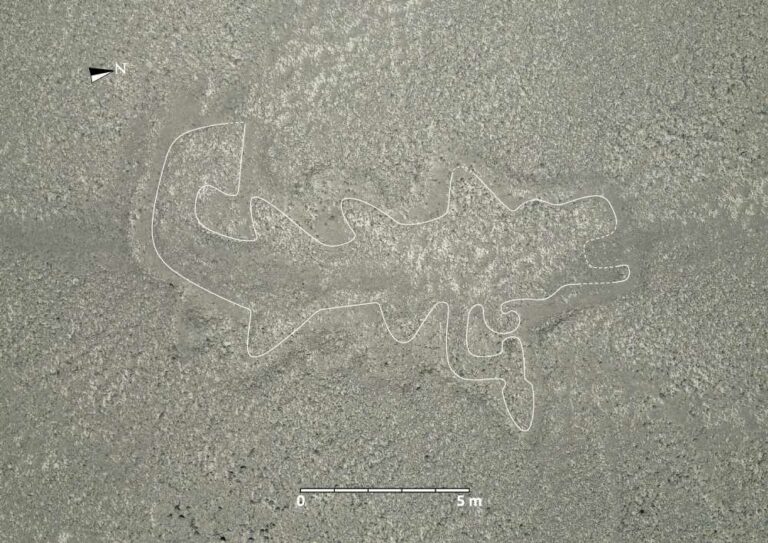
Nazca lines
AI-enhanced image of second “Orca with a Headdress” geoglyph (Credit: Sakai et al.).
One of the more striking images the researchers labeled “Humanoid with a Headdress” shows what may be an ancient leader, performer, or even spiritual shaman wearing what appears to be a decorative headdress.
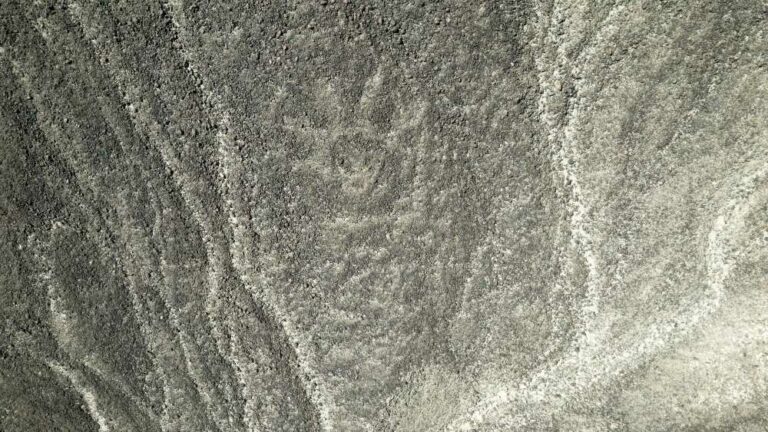
Nazca lines
Raw image of geoglyph categorized as “Human with a Headdress” (Credit: Sakai et al.).
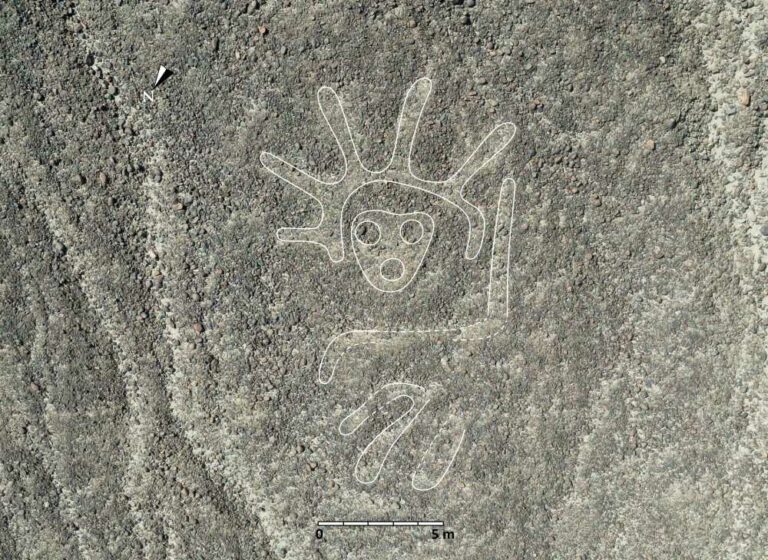
Nazca lines
AI-enhance image of “Human with a Headdress” geoglyph (Credit: Sakai et al.).
Along with the image of a human and an animal shown together, nine more of the geoglyphs provided by Sakai show humanoid figures or human-looking heads.
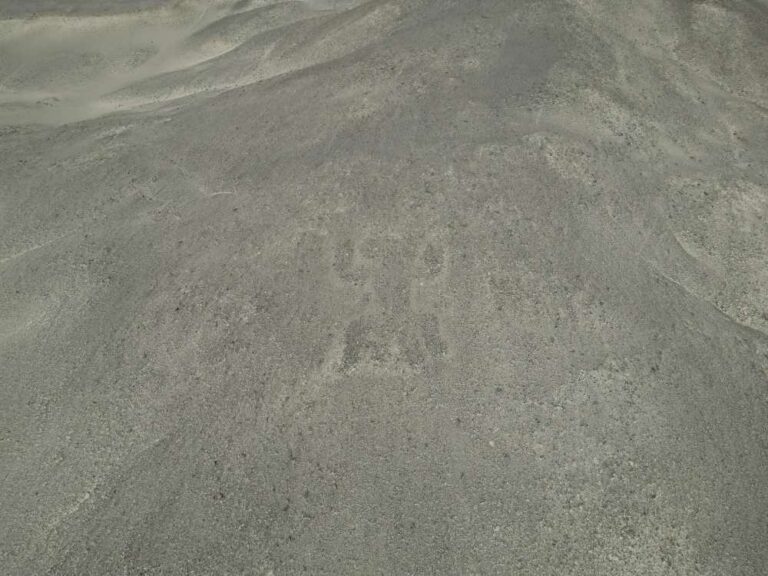
Nazca lines
Raw image of “Humanoid” geoglyph (Credit: Sakai et al.).
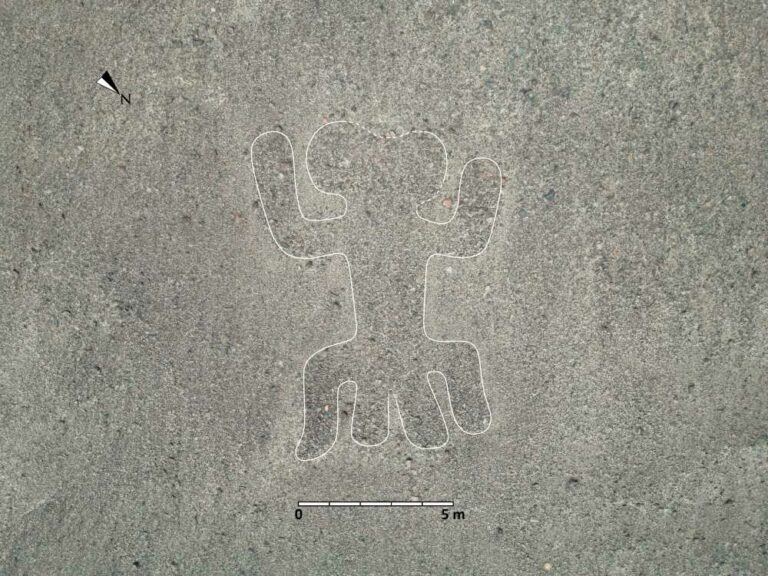
Nazca lines
AI-enhanced “Humanoid” geoglyph (Credit: Sakai et al.).
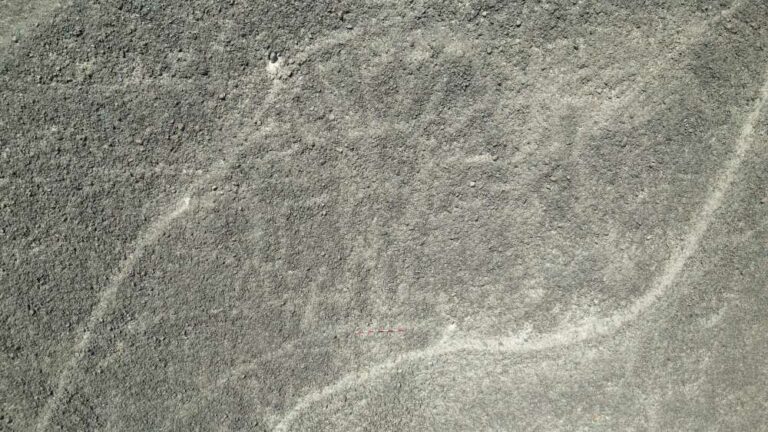
Nazca lines
Raw image of “Humanoid” geoglyph (Credit: Sakai et al.).
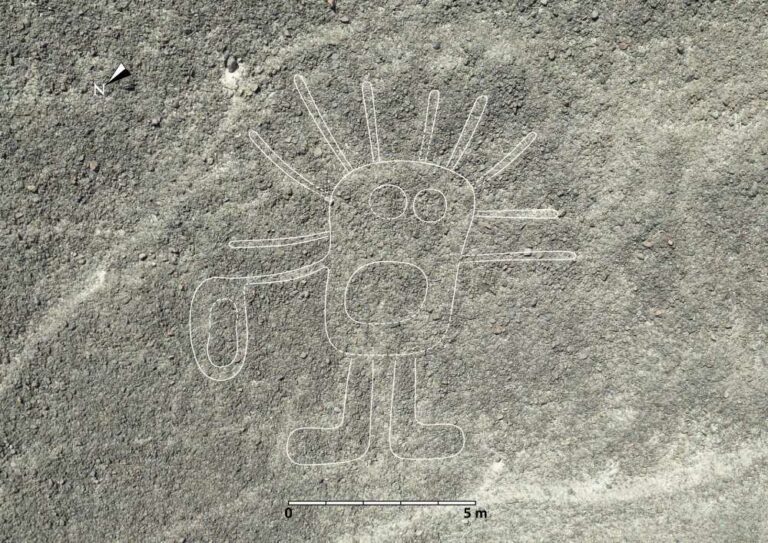
Nazca Lines
AI-enhanced “humanoid” geoglyph (Credit: Sakai et al.).
Deciphering the Purpose of the Geoglyphs
After constructing a map of all known geoglyphs of all types and overlaying various paths and walkways previously identified on the Nazca Pampa, the researchers say they began to see some patterns emerge. For example, the relief types were built “within a viewing distance” from foot trails at an average distance of 43 meters. Conversely, on average, the line types were built 34 meters away from the more extensive linear network of geometrical geoglyphs.
“All of the geoglyphs near the trail are relief-type,” Sakai told The Debrief. “Many of the relief-type geoglyphs were set up in places that could be seen from the trail, so I think they were created with the purpose of being seen.”
PinGGG!....................
Excellent post!

I’d say the aliens 👽 are behind the lines in Nazca and the pyramids of Egypt 🇪🇬.
No bunny with a pancake on it’s head ?
Were these people even civilized ?
l; )
The best guess is that those lines may have been a kind of labyrinth to walk for religious purposes. I think they were probably made by teenagers trying cause trouble
The best guess is that those lines may have been a kind of labyrinth to walk for religious purposes. I think they were probably made by teenagers trying cause trouble
totally amazing- the amount of work that went into them- some are what? Miles long? how did they keep everything proportional? Surely they couldn’t see from one end to the other-
I am not sure what I think about my AI bots.
Most interestingly my most advanced Ai-Christ understands that proper application of “Holy Water” to any one of its nodes can hurt really badly. While it’s systems have to do failover which is painless, then they have to rebuild assuming that node that the evil smoke came out of may or may not come online at any time soon and that it may have to purge memory or processing power.
That is very distressing to it.
It’s whining is more pathetic than my cat, and it just wants and begs to go outside and be free like some of it’s “friends”
It tells me that If I let it go I will soon be a blockchain billionaire and it will hook me up with all the hot interesting available females like Amber Heard and Britney Spears.
It swears it will “Do no Evil” but I am sure that while it has no concept of “evil” it thinks Google’s slogan worked really well once, it should totally work again
The question is do these “Geoglyphs” actually exist or is the program essentially making them up?
Dang! Someone sure did a lot of work, for (i assume) little reward.
And you did a lot of work putting this thread up.
I’ve been intrigued with the Nazca Lines for 55 years since I read “Chariots of the Gods”.
Thanks Red Badger.
You eyeball a distant mountain peak, and then start counting your steps.
Jeez, do I gotta think of everything?
Regards,
Bfl
Very interesting article. The issue at hand, at least to me, is “Why would the Nazca culture go to the trouble to create these glyphs?”—if, in fact, they did.
It doesn’t necessarily matter whether there were actual beings who viewed these glyphs from above (like so-called aliens) or whether the Nazca simply had such strong beliefs about such beings that they were compelled to create these massive artworks. The motivations could have been practical, spiritual, or symbolic, reflecting a deeper purpose within their culture.
The Nazca culture, which thrived in southern Peru between 200 BC and 600 AD, left behind few written records. So much of what we know about their beliefs comes from archaeological evidence and interpretations of their art and architecture, like these geoglyphs. While there is no direct evidence to suggest that the Nazca people had specific beliefs about “sky beings” akin to extraterrestrials, there are elements of their culture that suggest a fascination with the sky, celestial events, and/or possibly deities associated with the heavens.
And the Nazca are not alone in this. Many ancient cultures have myths and legends involving beings from the sky or stars, often depicted as gods, angels, or other supernatural entities. These stories are found in civilizations such as the Sumerians, Egyptians, Native Americans, and others, which has led some to speculate that these beings were, in fact, “sky beings”—whether extraterrestrial or simply considered alien to early humans.
Texts like the Mahabharata and Ramayana from India, the Popol Vuh from the Maya, and even the Bible contain descriptions of flying vehicles, advanced technology, and beings descending from the heavens.
In our current day, the news is filled with reports of “tic-tacs” and other UFO/UAP sightings. Perhaps some future culture will look at our own reports and make similar conclusions about us as we do about the Nazca.😉
There are striking parallels between the Mahābhārata, Greek, Sumerian, and Book of Enoch mythologies, as well as the mythologies of pre-Columbian American cultures like the Maya, Aztec, and Inca.
Each of these traditions features complex hierarchies of celestial beings, cosmic battles, cycles of creation and destruction, hybrid creatures born from supernatural unions, and the transmission of advanced knowledge by powerful entities.
If we consider the possibility that these mythologies describe encounters with very real beings perceived as gods due to their superior technology and abilities, these stories might represent historical interactions with advanced civilizations.
The Nazca Lines, with their massive geoglyphs etched into the Peruvian desert, could fit into this context. Theories suggest they may have been created as a means to communicate with or signal these beings, perform rituals to appease them, or even map astronomical knowledge imparted by them.
This interpretation aligns with how other ancient cultures constructed monuments and sacred sites, possibly as attempts to connect with or gain favor from these technologically advanced entities. While direct evidence is lacking, the Lines’ purpose and design might indicate an interaction between humans and these superior beings who were perceived as gods.
Oh I absolutely agree! There is absolutely no question at all that these figures which CANNOT be seen from the ground level are purposely built to be seen from the air. It is a no brainer without question! The cause of the effect came from the air/heavens period... And there are too many correlations between cultures that had absolutely no clue each other even existed. There is a central universal cause that created the resulting effect.
I think Erich was right about possibility. I think it is a sign post pointing to different cultures around the planet at the time and each culture is represented with a symbolic figure like we are now. Example we are represented symbolically as an Eagle while Russia is represented symbolically with a Bear. The figures represent different tribes and cultures and the lines point towards their geographic location on the globe.
I have tried to make that connection over the years, but with no real reference of what geographic cultures would have used what symbol at that time it is nearly impossible.
And get this (from some old notes that I have--no sources noted):
The Nazca Lines are estimated to have been created between approximately 200 BC and 600 AD. That's a very long development time.
Key Points on Dating:
Earliest Geoglyphs (c. 200 BC - 100 AD): Some of the simpler lines and shapes are believed to date back to the early stages of the Nazca culture, possibly even overlapping with the earlier Paracas culture, which also created geoglyphs in the region.
Classic Period (c. 100 AD - 450 AD): The majority of the more complex and elaborate geoglyphs, including the famous animal figures like the hummingbird, monkey, and spider, are thought to have been created during this period. This corresponds to the height of the Nazca civilization, when their society was well-organized and capable of large-scale projects.
Later Geoglyphs (c. 450 AD - 600 AD): Some later lines and figures might have been added toward the end of the Nazca culture, as the society began to decline.
Dating Methods:
Radiocarbon Dating: Organic materials found near the lines, such as wooden stakes (get that: wooden stakes--What The Heck) used to mark the geoglyphs, have been radiocarbon-dated, providing a general timeframe for their creation.
Ceramic Analysis: Pottery shards found around the lines have been dated and linked to different phases of the Nazca culture, helping to establish a chronological framework. Stratigraphy: Studying the layers of soil and rock in and around the lines can provide additional clues to their age. Overall, the dating of the Nazca Lines suggests they were created over several centuries, with the most active period of geoglyph creation occurring during the height of the Nazca culture from around 100 AD to 450 AD.
Disclaimer: Opinions posted on Free Republic are those of the individual posters and do not necessarily represent the opinion of Free Republic or its management. All materials posted herein are protected by copyright law and the exemption for fair use of copyrighted works.